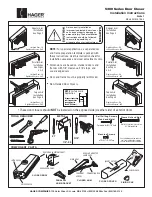
14
WARNING:
The reduction of input rating necessary for high
altitude installation may only be accomplished with
factory supplied orifices. Do not attempt to drill out
orifices in the field. Improperly drilled orifices may
cause fire, explosion, carbon monoxide poisoning,
personal injury or death.
The furnaces are shipped from the factory with orifices and
gas regulator settings for natural gas operation at sea level
altitudes. At 2,000 feet, the NFGC requires that this appliance
be derated 4% for each 1,000 feet of altitude. For example,
at 2,000 feet the input needs to be reduced 8%, at 3,000 feet
(12%), etc. This deration is in reference to the input rate and
gas heating value at sea level.
To derate the furnace requires knowing the heating value of
the gas at the installation site. Heating values at particular job
sites vary for two reasons:
1. The chemical mixture of the gas varies across regions and
is expressed as the “sea level heating value”.
2. The heating value varies by altitude. For this reason,
especially in high altitude areas, the local gas utility specifies
the heating value at the residence’s gas meter as the “local
value”.
WARNING:
This unit was equipped at the factory for use with
natural gas only. LP/Propane cannot be used with this
unit. Failure to follow safety warnings exactly could
result in serious injury, death or property damage.
START UP & ADJUSTMENTS
Pre-Start Check List
√
Verify the unit is level and allows condensate to drain.
√
Verify all clearance requirements are met and there is free
airflow to and from the outdoor coil.
√
Verify that the duct work is sealed to prevent air leakage
and air filter is installed.
√
Verify that the line voltage power leads are securely
connected and the unit is properly grounded.
√
Verify that the low voltage wires are securely connected to
the correct terminals in the low voltage area of the control
box.
√
Verify that the gas line service pressure does not exceed
10.0 inches WC (0.36 psig), and is not less than 4.5 inches
WC (0.16 psig) for natural gas.
√
Verify that the burner limit control is closed. If necessary,
press the red button to reset the control.
DO NOT
install a
jumper wire across the control to defeat its function. If the
control reopens upon start-up,
DO NOT
reset the control
without identifying and correcting the fault condition which
caused the control to trip.
√
Verify that the gas line has been purged and all connections
are leak tight.
√
Verify that all exterior panels are replaced and securely
fastened.
√
Verify that the outdoor fan turns freely.
√
Verify that the power supply branch circuit overcurrent
protection is sized properly.
√
Verify that the thermostat is wired correctly. The thermostat
function switch should be set to OFF and the thermostat
fan switch should be set to AUTO.
Start-Up Procedure
WARNING:
If this unit is equipped with crankcase heaters, allow
24 hrs for heating of the refrigerant compressor
crankcase prior to start up or anytime the power
has been removed for more than 12 hrs. Failure to
comply may result in damage or cause premature
failure of the system.
Air Circulation
Leave the thermostat system mode on OFF, and set the fan
mode to ON. Blower should run continuously. Check the air
delivery at the supply registers and adjust register openings
for balanced air distribution. Examine ductwork for leaks or
obstruction if insufficient air is detected. Set the thermostat
fan mode to AUTO. The blower should stop running.
System Cooling
1. Set the thermostat’s system mode to COOL and the fan
mode to AUTO. Gradually lower the thermostat temperature
setpoint below room temperature and verify the compressor,
fan and indoor blower energize.
2. Feel the air being circulated by the indoor blower and verify
that it is cooler than ambient temperature. Listen for any
unusual noises. If unusual sounds occur, determine the
source of the noise and correct as necessary.
3. Allow the cooling system to operate for several minutes and
then set the temperature selector above room temperature.
Verify the fan and compressor cycle off with the thermostat.
NOTE:
The blower will also stop after a 60 second delay.
System Heating
1. Set the thermostat to the lowest setting.
2. Follow the procedures given on the operating instruction
label, this manual or attached inside the louvered control
access panel.
3. Set the thermostat above room temperature and verify the
Operating Sequence. See
4. Verify that the compressor and outdoor fan motor are not
energized.
5. After the unit has run for approximately five minutes, set the
thermostat below room temperature and verify the shutdown
sequence; steps 10, 11, & 12 in the Operating Sequence
Verifying & Adjusting Temperature Rise
Verify the temperature rise through the unit is within the range
specified on the unit data label. Temperature rises outside
the specified range could result in premature heat exchanger
failure.
1. Place thermometers in the return and supply air stream as
close to the unit as possible. The thermometer on the supply
air side must be shielded against direct radiation from the
heat exchanger to avoid false readings.
2. Adjust all registers and duct dampers to the desired
position. Run the unit for 10 to 15 minutes before taking any
temperature readings. The temperature rise is the difference
between the supply and return air temperatures.
NOTE:
For typical duct systems, the temperature rise will
fall within the range specified on the data label (with the
blower speed at the factory recommended setting) shown in















































